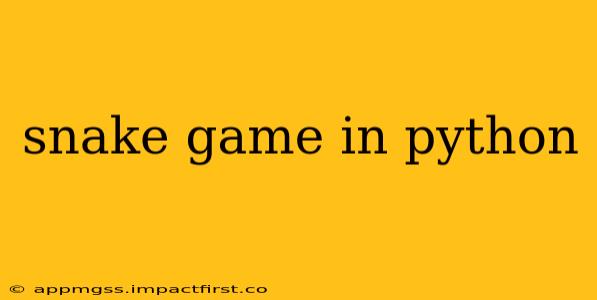The classic Snake game, a timeless arcade favorite, is a perfect project for learning Python programming. This guide will walk you through creating a functional and engaging Snake game using the Pygame library. We'll cover the fundamentals, explain the code step-by-step, and explore ways to enhance your game.
Getting Started: Installing Pygame
Before we begin, ensure you have Pygame installed. Open your terminal or command prompt and type:
pip install pygame
This command will download and install the necessary libraries.
The Core Game Logic: Movement and Collision Detection
The heart of the Snake game lies in managing the snake's movement and detecting collisions with itself or the boundaries. Here's a simplified breakdown:
-
Snake Representation: We'll represent the snake as a list of coordinates, each representing a segment of the snake's body. The head is the first element, and the tail is the last.
-
Movement: The snake moves by adding a new segment at the head, based on the direction of movement (up, down, left, right).
-
Collision Detection: We need to check if the snake's head collides with:
- The Walls: Game over if the snake hits the boundaries of the game window.
- Its Own Body: Game over if the snake's head hits any other segment of its body.
- The Food: If the snake's head collides with the food, the snake grows longer, and new food is generated.
Pygame Implementation: A Step-by-Step Approach
Let's dive into the Python code. This example focuses on the core game mechanics:
import pygame
import random
# Initialize Pygame
pygame.init()
# Set window dimensions
window_width = 600
window_height = 400
window = pygame.display.set_mode((window_width, window_height))
pygame.display.set_caption("Snake Game")
# Colors
black = (0, 0, 0)
white = (255, 255, 255)
red = (255, 0, 0)
green = (0, 255, 0)
# Snake initial position and size
snake_x = window_width / 2
snake_y = window_height / 2
snake_size = 10
snake_list = []
snake_length = 1
# Food initial position
food_x = round(random.randrange(0, window_width - snake_size) / 10.0) * 10.0
food_y = round(random.randrange(0, window_height - snake_size) / 10.0) * 10.0
# Game variables
game_over = False
x_change = 0
y_change = 0
clock = pygame.time.Clock()
snake_speed = 15
# Game loop
while not game_over:
for event in pygame.event.get():
if event.type == pygame.QUIT:
game_over = True
if event.type == pygame.KEYDOWN:
if event.key == pygame.K_LEFT:
x_change = -snake_size
y_change = 0
elif event.key == pygame.K_RIGHT:
x_change = snake_size
y_change = 0
elif event.key == pygame.K_UP:
y_change = -snake_size
x_change = 0
elif event.key == pygame.K_DOWN:
y_change = snake_size
x_change = 0
# Check for boundaries
if snake_x >= window_width or snake_x < 0 or snake_y >= window_height or snake_y < 0:
game_over = True
# Update snake position
snake_x += x_change
snake_y += y_change
# Draw everything
window.fill(black)
pygame.draw.rect(window, red, [food_x, food_y, snake_size, snake_size])
snake_head = []
snake_head.append(snake_x)
snake_head.append(snake_y)
snake_list.append(snake_head)
if len(snake_list) > snake_length:
del snake_list[0]
for x in snake_list[:-1]:
if x == snake_head:
game_over = True
for x in snake_list:
pygame.draw.rect(window, green, [x[0], x[1], snake_size, snake_size])
pygame.display.update()
clock.tick(snake_speed)
pygame.quit()
quit()
This provides a basic functional Snake game. Remember to save this as a .py file (e.g., snake_game.py) and run it from your terminal using python snake_game.py.
Improving the Game: Adding Features and Enhancements
This basic framework can be significantly enhanced. Consider adding:
- Scorekeeping: Track and display the player's score.
- Difficulty Levels: Adjust the snake's speed and food generation rate.
- Sound Effects: Incorporate sound effects for eating food, game over, etc.
- Graphics: Use more sophisticated graphics for the snake and food.
- Game Over Screen: Display a "Game Over" screen with the final score.
Troubleshooting and FAQs
How do I handle self-collision?
The code above includes a check to see if the snake's head collides with any other segment of its body. This is done by iterating through the snake_list and comparing the head's coordinates to the coordinates of each other segment.
How can I make the game faster or slower?
You can adjust the snake_speed variable in the code. A higher value means a faster game.
My snake is not moving smoothly.
Ensure your x_change and y_change are correctly updated based on key presses. Also, make sure the clock.tick(snake_speed) line is present to control the game's frame rate.
This comprehensive guide provides a solid foundation for building your own Snake game in Python. Remember to experiment, add features, and personalize your game to make it unique!
